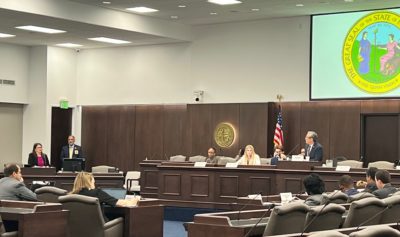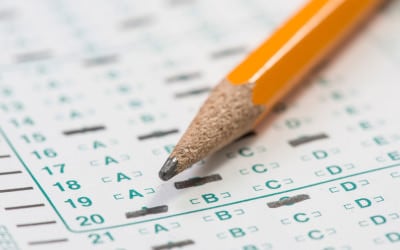
Share this story
Many of North Carolina’s students are in the middle of taking their standardized tests, or just wrapping them up. Whether it’s an end-of-grade test or the SAT for college admissions, taking these tests is a significant part of the school experience, and we’ve gotten many questions from you about why students take these tests and how they work.
Keep reading to find out the answer to these questions and more.
What’s a standardized test?
A standardized test is any test that is administered and scored in the same way for all who take the test.
Usually, when people refer to “standardized tests,” they are thinking of tests (often developed by a company) that are required by a school district, a higher education institution, or a state.
Here’s one example: The SAT was developed by an organization called College Board. Some universities require students to submit their SAT scores when they apply.
A teacher giving a multiple choice and essay question test at the conclusion of a unit on, say, ancient Rome to her history class could technically be classified as a standardized test, but that’s not usually the type of test people are referring to when they say “standardized tests.”
What about in North Carolina?
In North Carolina, there are a variety of standardized tests that students might have to take in any given year. The most common ones are “End-of-Grade” tests — or EOGs.
Unlike the SAT, North Carolina’s EOGs are developed not by a company, but by the state.
Students in North Carolina public schools take reading and math EOGs in third through eighth grades and science EOGs in fifth and eighth grades. The purpose of these, according to the state Department of Public Instruction (DPI), is to “measure student performance on the goals, objectives, and grade-level competencies.”
But wait, what about EOCs? Yep, there’s something called an EOC. That’s an End-of-Course test, which is given to North Carolina students at the end of English II, Math 1, Math 3, and biology. (These are all typically high school tests.)
There’s also Read to Achieve (RtA) testing, which affects all North Carolina third graders. They take a “baseline” test at the beginning of third grade to determine their reading skills.
And there’s the ACT, often used for college admissions, which is administered to all North Carolina 11th graders every year.
There are also some other tests that are less common, but still important:
- One is the National Assessment of Educational Progress (NAEP), which some call “The Nation’s Report Card.” Every two years, a sampling of North Carolina fourth, eighth, and 12th graders take the NAEP. This helps compare performance among states (i.e. how do North Carolina fourth graders stack up against, say, Michigan fourth graders in math?) as well as trends over time.
- Another is WorkKeys — a variety of assessments for students who are Career and Technical Education (CTE) concentrators and which determine whether those students receive their National Career Readiness Certificate.
- There’s also the NCEXTEND1, which is an alternative assessment for some students with disabilities.
How are these test scores used?
Well, different tests are used for different purposes.
Test results from reading and math EOGs in third through eighth grades help determine school and district performance scores for state and federal accountability purposes.
Let’s start with third grade: baseline reading testing is given to all third graders at the beginning of the school year — they call it “Beginning-of-Grade-3 Reading Test” or “BOG3.” For kids who do really well on BOG3 (level 3 or higher), they’re basically good to go. They’ve already fulfilled third grade reading requirements, and they’ll count as “proficient” toward their school’s performance grade. Pair that with the third grade reading EOG and the state can use the data to help identify which teachers would be a good fit for teaching reading camps. (A teacher whose students are demonstrating a lot of reading growth from the BOG3 to the EOG is someone the state wants teaching struggling readers during the summer.)
Reading camps are summer programs for any third grade student who doesn’t demonstrate reading proficiency on their third grade BOG3 or EOG. (First and second graders can also be eligible for these camps.) They’re designed to help struggling readers improve.
Test results from reading and math EOGs in third through eighth grades help determine school and district performance scores for state and federal accountability purposes. For example, North Carolina has “School Report Cards” to provide information about how schools and districts are performing.
Although this has been suspended during the pandemic, schools are given a grade based on multiple measures of their performance — including on EOGs. These grades determine which schools and districts are identified as needing additional support from the state and federal government. Many people also use these grades to learn about a school, perhaps before buying a home in that school zone or in trying to find a new school for their child.
There’s also the Education Value-Added Assessment System (EVAAS). EVAAS is a software system that collects data from standardized tests like EOGs to measure student growth. According to DPI: “EVAAS provides North Carolina’s educators with tools to improve student learning and to reflect and improve on their own effectiveness.”
One thing to note: student “growth” is different from “achievement.” Achievement defines how a student performs at a single moment in time — for example, they may score “proficient” on their BOG3. Growth, however, is how a student performs over time — so, for example, the difference between how they performed on their BOG3 and their EOG.
Results from all EOCs are required by law to be used as at least 20% of a student’s final grade in each respective course. And, like EOGs, their results are used to help determine school and district performance scores for state and federal accountability purposes.
The ACT is used for accountability purposes, too. It can also be used in the college application process.
What about charter schools?
They’ve got to take standardized tests, too. While there are some rules and regulations that don’t apply to charter schools, standardized testing isn’t one of them. Charter schools must administer all assessments the state requires.
Charter schools also receive grades via North Carolina School Report Cards, too. Here’s one example. On top of that, when the State Board of Education is deciding whether a charter school is allowed to continue operating — or has to be shut down — that decision can be based in part on how its students perform academically on standardized tests.
What are your questions about education in North Carolina? You can reach us on Instagram, Twitter, and Facebook. You can also tell us your thoughts on our “Contact Us” form.




